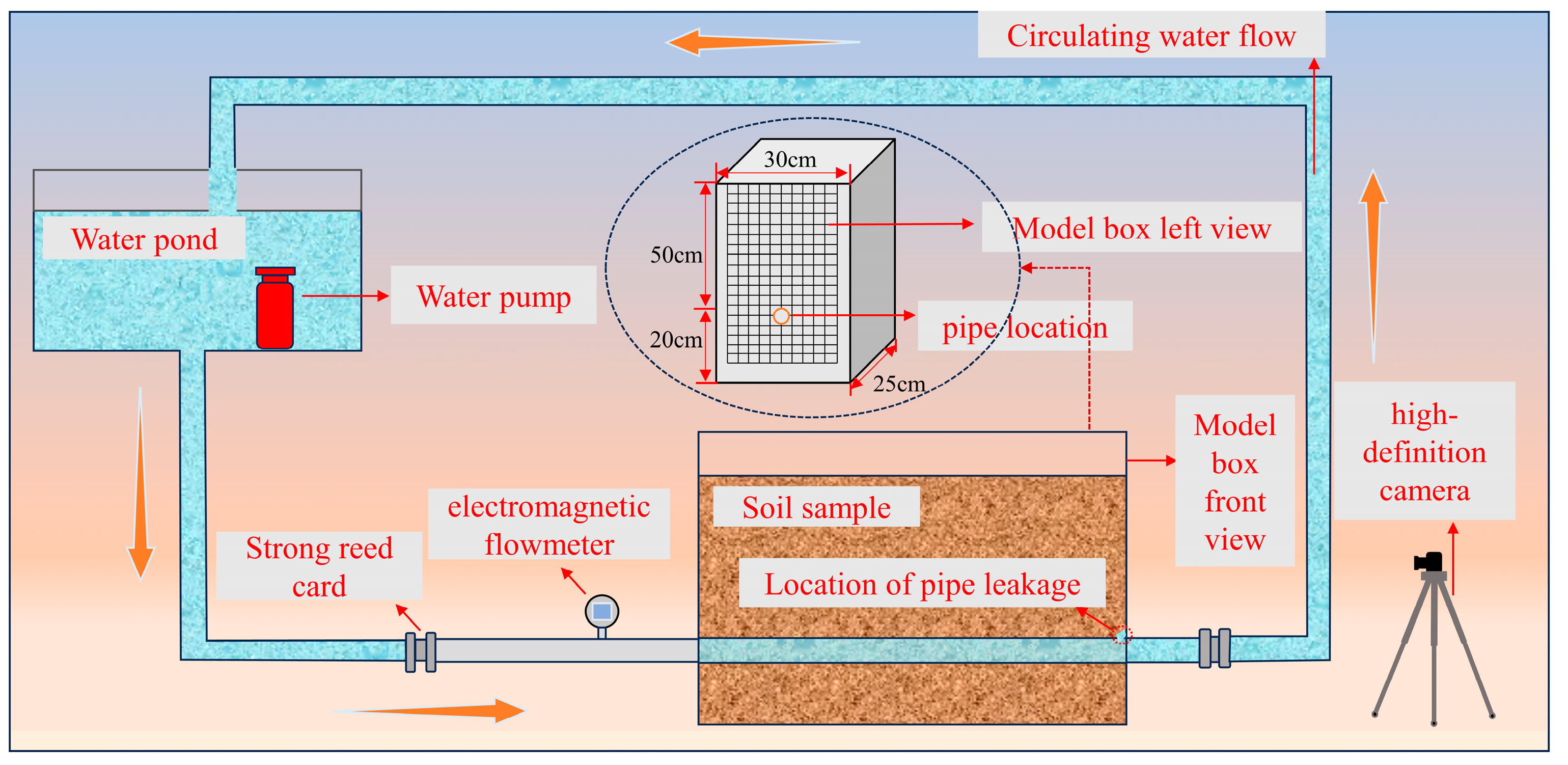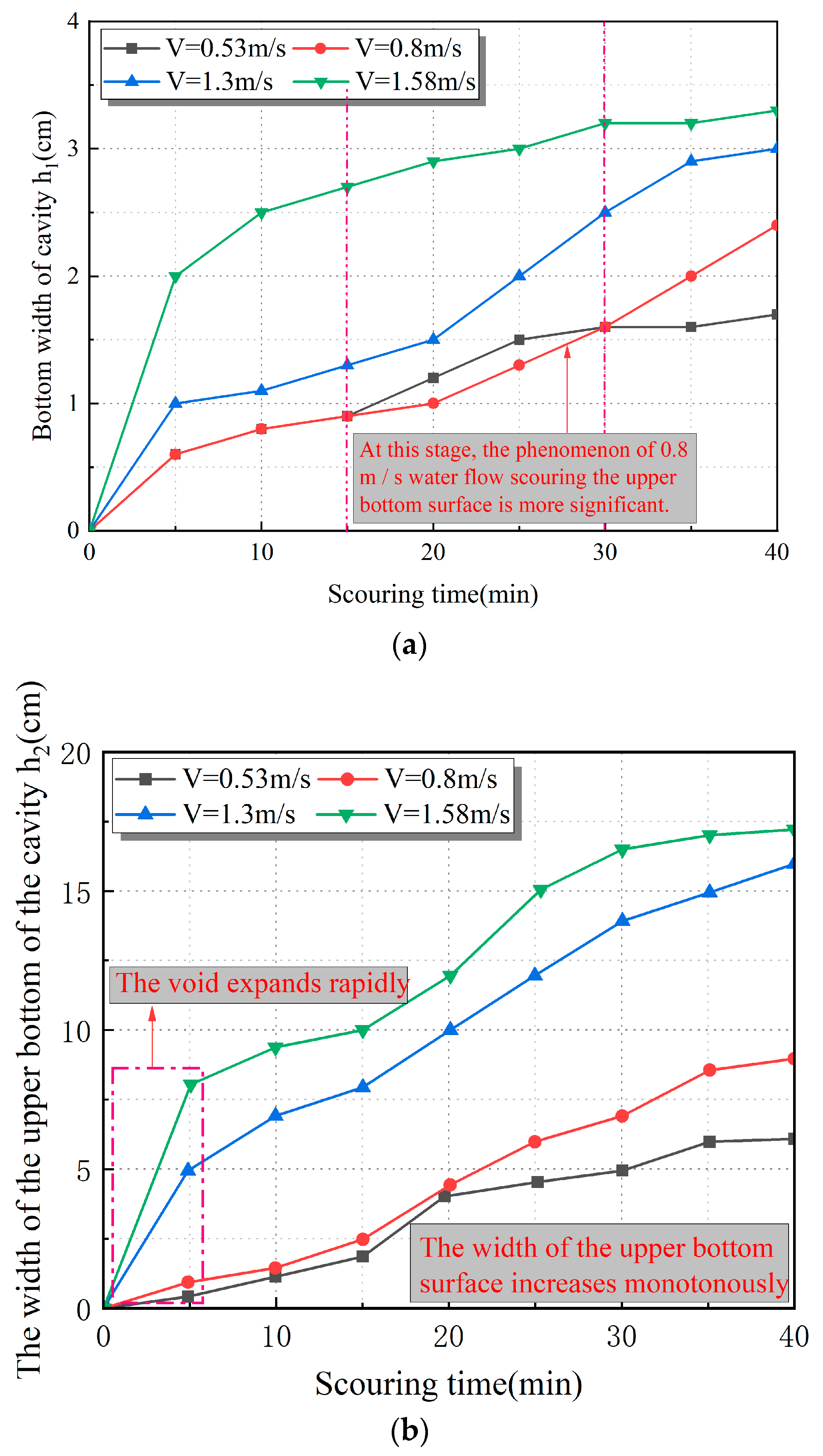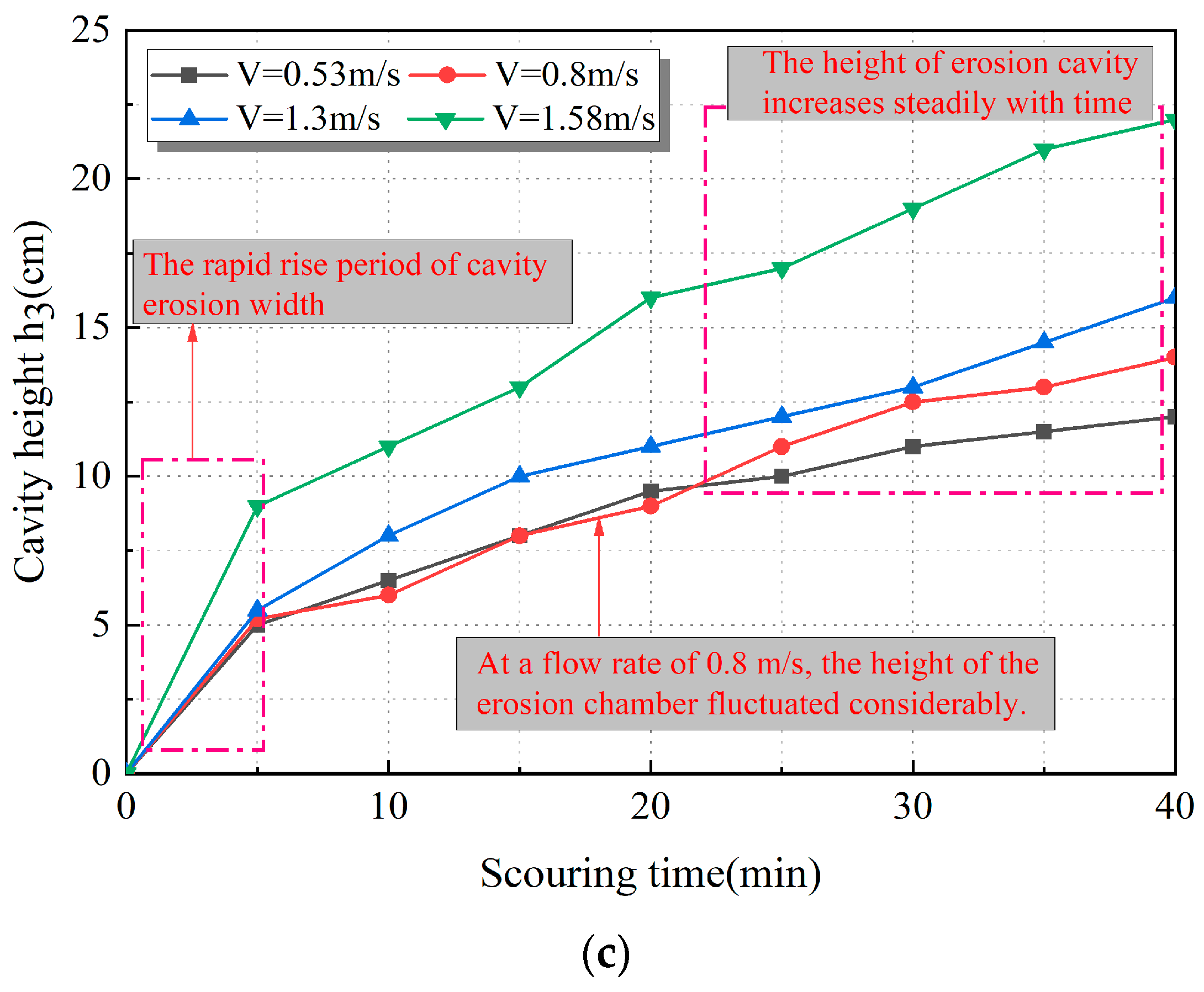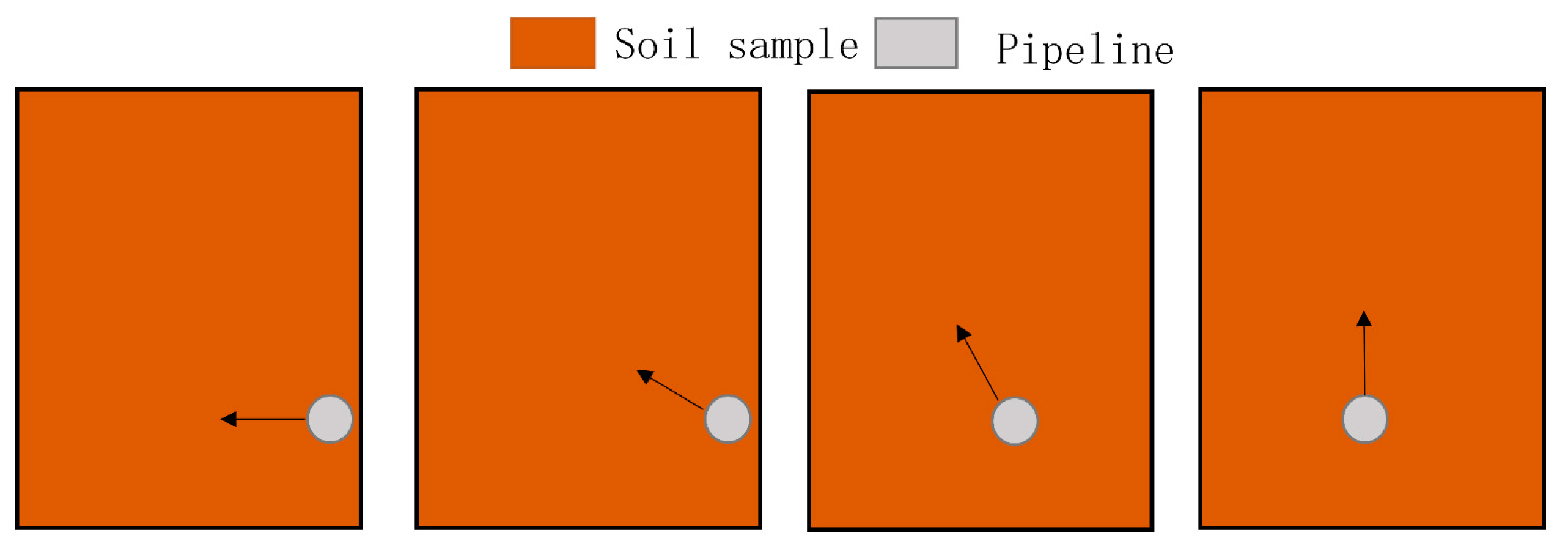Study on the Influence of Urban Water Supply Pipeline Leakage on the Scouring Failure Law of Cohesive Soil Subgrade
Abstract
:1. Introduction
2. Content and Methods of Testing
2.1. Test Soil Samples
2.2. Testing Apparatus
2.3. Experimental Materials and Procedures
- The soil samples were tiled and subsequently dried, after which they were crushed using a crusher (as shown in Figure 3a).
- According to the geotechnical test method, the test sample particles were prepared with a water content of 15%. Subsequently, the samples were allowed to stand for 24 h (as shown in Figure 3b).
- To prevent test delamination, the sample was compacted using a compaction hammer, and its surface subsequently polished once the compaction process was finished (as shown in Figure 3c).
- Based on the principles of similarity theory, the pipeline was installed at ground level (20 cm) while the soil above it had a thickness of 10 cm (as shown in Figure 3d).
2.4. Test Scheme
3. Analysis of Test Results
3.1. Pipeline Leakage Erosion Test Phenomenon
- Soil cavity development stage: as the erosion time progresses, the erosion cavity starts to form above the leakage point. Water flow infiltrates the soil particles in regions of weakness, leading to the formation of small cracks in localized areas. Initially, the cavity has a small volume and is filled with a mixture of water and soil. Meanwhile, the surrounding soil remains largely unchanged except for a slight increase in water content. The red curve represents the area of the cavity (as shown in Figure 4b–d).
- Soil cavity expansion stage: the erosion rate of the soil cavity accelerates, leading to its expansion. Figure 4f–i depict a substantial removal of soil within the cavity due to extensive erosion. The formation of voids can be attributed to the displacement caused by water flow expelled from a leaky pipe, leading to the rearrangement of soil particles and subsequent void formation. The diagram reveals that, in the experimental group, the right side of the soil sustains more severe damage than the left side, particularly within the first 30 min. Similarly, other experimental groups also exhibited an imbalance in the volume development between the left and right cavities.
3.2. The Effect of Water Flow Velocity on Cavity Development
3.3. The Effect of Leakage Orifice Size on Cavity Development
3.4. The Effect of Leakage Angle on Cavity Development
4. Numerical Simulation Study
4.1. Test Properties of Samples
4.2. Conclusions and Analysis
5. Conclusions
- The erosion rate exhibits a positive correlation with the water flow rate, with the largest underground cavity volume observed during the erosion test conducted at a flow rate of 1.58 m/s. Similarly, the erosion rate shows a positive correlation with the size of the leakage port, with the largest underground cavity volume observed when the leakage port size was 8 mm. In the range of 0 to 90° leakage angles, the erosion rate demonstrated a positive correlation with the leakage angle. Notably, the largest volume of the underground cavity occurred when the leakage angle was 90°.
- After the pipeline is broken and leaks, the cohesive force of the soil sample near the leakage port gradually decreases due to the water flow. This decrease in cohesive force leads to an increase in the starting velocity of soil particles, the starting shear stress, and the discrete velocity of soil particles. Additionally, the soil loss rate gradually increases as the water flow within the cavity increases.
- The numerical model of the underground cavity formed by leakage erosion was analyzed, and the development process of the cavity was summarized into three stages. The physical model test T-2 group and numerical simulation were employed to mutually verify each other. The results affirmed the reliability of the numerical simulation findings.
Author Contributions
Funding
Data Availability Statement
Conflicts of Interest
References
- Wang, X.W.; Xu, Y.S. Investigation on the phenomena and influence factors of urban ground collapse in China. Nat. Hazards 2022, 113, 1–33. [Google Scholar] [CrossRef]
- Wang, K.; Zhang, J.W.; Gao, G.Q.; Qiu, J.L.; Zhong, Y.J.; Guo, C.X.; Zhao, W.C.; Tang, K.J.; Su, X.L. Causes, risk analysis, and countermeasures of urban road collapse in China from 2019 to 2020. J. Perform. Constr. Facil. 2022, 36, 04022054. [Google Scholar] [CrossRef]
- Zhang, C.L.; Oh, J.; Park, K. Evaluation of sewer network resilience index under the perspective of ground collapse prevention. Water Sci. Technol. 2022, 85, 188–205. [Google Scholar] [CrossRef] [PubMed]
- Dong, X. Analysis of Environmental Factors Impact on Urban Underground Pipelines. Adv. Mater. Res. 2014, 1065–1069, 2570–2576. [Google Scholar] [CrossRef]
- Guo, S.; Jiang, Y.H.; Tang, Y.; Cheng, H.K.; Lv, Y.Z.; Li, M. Experimental study on the soil erosion through a defective pipe under the cyclic infiltration-exfiltration flow. Transp. Geotech. 2023, 42, 101085. [Google Scholar] [CrossRef]
- Tan, F.; Tan, W.F.Y.; Yan, F.F.; Qi, X.; Li, Q.H.; Hong, Z.K. Model Test Analysis of Subsurface Cavity and Ground Collapse Due to Broken Pipe Leakage. Appl. Sci. 2022, 12, 13017. [Google Scholar] [CrossRef]
- Ben-Mansour, R.; Habib, M.A.; Khalifa, A.; Youcef-Toumi, K.; Chatzigeorgiou, D. Computational fluid dynamic simulation of small leaks in water pipelines for direct leak pressure transduction. Comput. Fluids 2012, 57, 110–123. [Google Scholar] [CrossRef]
- Li, X.J.; Chen, R.; Liu, L.L.; Zhou, C.; Bate, B. A non-Darcy flow CFD–DEM method for simulating ground collapse induced by leakage through underground pipeline defect. Comput. Geotech. 2023, 162, 105695. [Google Scholar] [CrossRef]
- Tang, Y.; Chan, D.H.; Zhu, D.Z. A coupled discrete element model for the simulation of soil and water flow through an orifice. Int. J. Numer. Anal. Meth. Geomech. 2017, 41, 1477–1493. [Google Scholar] [CrossRef]
- Qi, G.; Wang, Z.Y.; Chen, Y.; Zhu, C.; Ren, D.Z.; Tian, T.; Yang, F. Analysis of instability mechanism and induced cause of urban pavement in Xining City, China. Adv. Mater. Sci. Eng. 2022, 2022, 3365402. [Google Scholar] [CrossRef]
- Zhou, H.T.; Liu, C.H.; Wang, G.H.; Kang, K.; Liu, Y.H. Study on drilling ground collapse induced by groundwater flow and prevention based on a coupled CFD-DEM method. KSCE J. Civ. Eng. 2022, 26, 2112–2125. [Google Scholar] [CrossRef]
- Rahnema, H.; Mirassi, S.; Dal Moro, G. Cavity effect on Rayleigh wave dispersion and P-wave refraction. Earthq. Eng. Eng. Vib. 2021, 20, 79–88. [Google Scholar] [CrossRef]
- Long, Y.Y.; Tan, Y. Soil arching due to leaking of tunnel buried in water-rich sand. Tunn. Undergr. Space Technol. 2020, 95, 103158. [Google Scholar] [CrossRef]
- Xiong, H.; Wu, H.; Bao, X.H.; Fei, J.B. Investigating effect of particle shape on suffusion by CFD-DEM modeling. Constr. Build. Mater. 2021, 289, 123043. [Google Scholar] [CrossRef]
- Mohamed, H.I.; Rabey, S.H.; Darweesh, M.S. Laboratory investigation of ground surface settlement caused by erosion around a leaking pipe. J. Pipeline Syst. Eng. Pract. 2022, 13, 04021080. [Google Scholar] [CrossRef]
- Zhang, D.M.; Du, W.W.; Peng, M.Z.; Feng, S.J.; Li, Z.L. Experimental and numerical study of internal erosion around submerged defective pipe. Tunn. Undergr. Space Technol. 2020, 97, 103256. [Google Scholar] [CrossRef]
- Ali, H.; Choi, J. Risk prediction of sinkhole occurrence for different subsurface soil profiles due to leakage from underground sewer and water pipelines. Sustainability 2019, 12, 310. [Google Scholar] [CrossRef]
- Mukunoki, T.; Kumano, N.; Otani, J.; Kuwano, R. Visualization of three dimensional failure in sand due to water inflow and soil drainage from defective underground pipe using X-ray CT. Soils Found. 2009, 49, 959–968. [Google Scholar] [CrossRef]
- Mukunoki, T.; Kumano, N.; Otani, J. Image analysis of soil failure on defective underground pipe due to cyclic water supply and drainage using X-ray CT. Front. Struct. Civ. Eng. 2012, 6, 85–100. [Google Scholar] [CrossRef]
- Guo, S.; Shao, Y.; Zhang, T.Q.; Zhu, D.Z.; Zhang, Y.P. Physical modeling on sand erosion around defective sewer pipes under the influence of groundwater. J. Hydraul. Eng. 2013, 139, 1247–1257. [Google Scholar] [CrossRef]
- Guo, S.; Zhu, D.Z. Soil and groundwater erosion rates into a sewer pipe crack. J. Hydrol. Eng. 2017, 143, 06017008. [Google Scholar] [CrossRef]
- Wang, Y.X.; Shi, G.; Tian, X.W.; Li, C.Y.; Cheng, H.Y. Experimental study on city road collapse under vibrating load. Shock Vib. 2020, 2020, 6074658. [Google Scholar] [CrossRef]
- Indiketiya, S.; Jegatheesan, P.; Rajeev, P. Evaluation of defective sewer pipe-induced internal erosion and associated ground deformation using laboratory model test. Can. Geotech. J. 2017, 54, 1184–1195. [Google Scholar] [CrossRef]
- Sato, M.; Kuwano, R. Influence of location of subsurface structures on development of underground cavities induced by internal erosion. Soils Found. 2015, 55, 829–840. [Google Scholar] [CrossRef]
- He, Y.X.; Zhu, D.Z.; Zhang, T.Q.; Shao, Y.; Yu, T.C. Experimental observations on the initiation of sand-bed erosion by an upward water jet. J. Hydraul. Eng. 2017, 143, 06017007. [Google Scholar] [CrossRef]
- Helal, E. Experimental evaluation of changes in channel bed morphology due to a defective pressure flow pipe. J. Irrig. Drain. Eng. 2019, 145, 04019022. [Google Scholar] [CrossRef]
- Zhao, A.H.; Ma, Y.K.; Liu, J.; Li, Y.B.; Zhong, Q.; Yuan, H.Y.; Fu, M. Morphological Characteristics of Overlying Soil Eroded by Leakage Gas from Buried Pipelines. J. Pipeline Syst. Eng. Pract. 2021, 12, 04021063. [Google Scholar] [CrossRef]











| Density (g/cm3) | Median Diameter D50 (um) | Water Content (%) | Force of Cohesion c (kPa) | Angle of Internal Friction (°) | Void Ratio | Permeability Coefficient (m/s) |
|---|---|---|---|---|---|---|
| 1.75 | 6.42 | 16.8 | 21. 5 | 20.16 | 0.65 | 5 × 10−6 |
| Test Number | Number | Flow Velocity v1 (m/s) | Leakage Port Size d2 (mm) | Leakage Port Angle φ (°) |
|---|---|---|---|---|
| T-1 | 1 | 0.56 | 6 | 90 |
| 2 | 0.8 | 6 | 90 | |
| 3 | 1.3 | 6 | 90 | |
| 4 | 1.58 | 6 | 90 | |
| T-2 | 5 | 1.3 | 2 | 90 |
| 6 | 1.3 | 4 | 90 | |
| 7 | 1.3 | 6 | 90 | |
| 8 | 1.3 | 8 | 90 | |
| T-3 | 9 | 1.3 | 6 | 0 |
| 10 | 1.3 | 6 | 30 | |
| 11 | 1.3 | 6 | 60 | |
| 12 | 1.3 | 6 | 90 |
| Water Flow Velocity v1 (m/s) | Test Number | Time t (s) | Lower Bottom Erosion Average Rate E1 (mm/s) | Average Erosion Rate of Upper Bottom Surface E2 (mm/s) | Height Average Erosion Rate E3 (mm/s) | Volume Erosion Average Rate E4 (mm3/s) |
|---|---|---|---|---|---|---|
| 0.53 | 1 | 2400 | 0.0108 | 0.0312 | 0.0255 | 0.0145 |
| 0.8 | 2 | 2400 | 0.0112 | 0.0519 | 0.0351 | 0.0484 |
| 1.3 | 3 | 2400 | 0.0165 | 0.0903 | 0.0939 | 0.2200 |
| 1.58 | 4 | 2400 | 0.0286 | 0.0950 | 0.1226 | 0.3015 |
| Median Particle Size (μm) | Density (g/cm3) | Critical Shields Number | Underwater Repose Angle | Bed Load Coefficient | Carryover Coefficient |
|---|---|---|---|---|---|
| 6.42 | 1.75 | 0.0382 | 36° | 8 | 0.018 |
| T-2 | Cavity Volume (m3) | Error Rate (%) | |
|---|---|---|---|
| Physical Model | Numerical Simulation | ||
| 1-1 | 0.0784 | 0.0921 | 13.5 |
| 1-2 | 0.3545 | 0.3759 | 8.8 |
| 1-3 | 1.1145 | 1.1326 | 9.8 |
| 1-4 | 1.3456 | 1.4845 | 10.3 |
Disclaimer/Publisher’s Note: The statements, opinions and data contained in all publications are solely those of the individual author(s) and contributor(s) and not of MDPI and/or the editor(s). MDPI and/or the editor(s) disclaim responsibility for any injury to people or property resulting from any ideas, methods, instructions or products referred to in the content. |
© 2023 by the authors. Licensee MDPI, Basel, Switzerland. This article is an open access article distributed under the terms and conditions of the Creative Commons Attribution (CC BY) license (https://creativecommons.org/licenses/by/4.0/).
Share and Cite
Mao, J.; Wang, Y.; Zhang, H.; Jing, X. Study on the Influence of Urban Water Supply Pipeline Leakage on the Scouring Failure Law of Cohesive Soil Subgrade. Water 2024, 16, 93. https://doi.org/10.3390/w16010093
Mao J, Wang Y, Zhang H, Jing X. Study on the Influence of Urban Water Supply Pipeline Leakage on the Scouring Failure Law of Cohesive Soil Subgrade. Water. 2024; 16(1):93. https://doi.org/10.3390/w16010093
Chicago/Turabian StyleMao, Jingxin, Yijun Wang, Hao Zhang, and Xiaofei Jing. 2024. "Study on the Influence of Urban Water Supply Pipeline Leakage on the Scouring Failure Law of Cohesive Soil Subgrade" Water 16, no. 1: 93. https://doi.org/10.3390/w16010093
APA StyleMao, J., Wang, Y., Zhang, H., & Jing, X. (2024). Study on the Influence of Urban Water Supply Pipeline Leakage on the Scouring Failure Law of Cohesive Soil Subgrade. Water, 16(1), 93. https://doi.org/10.3390/w16010093




